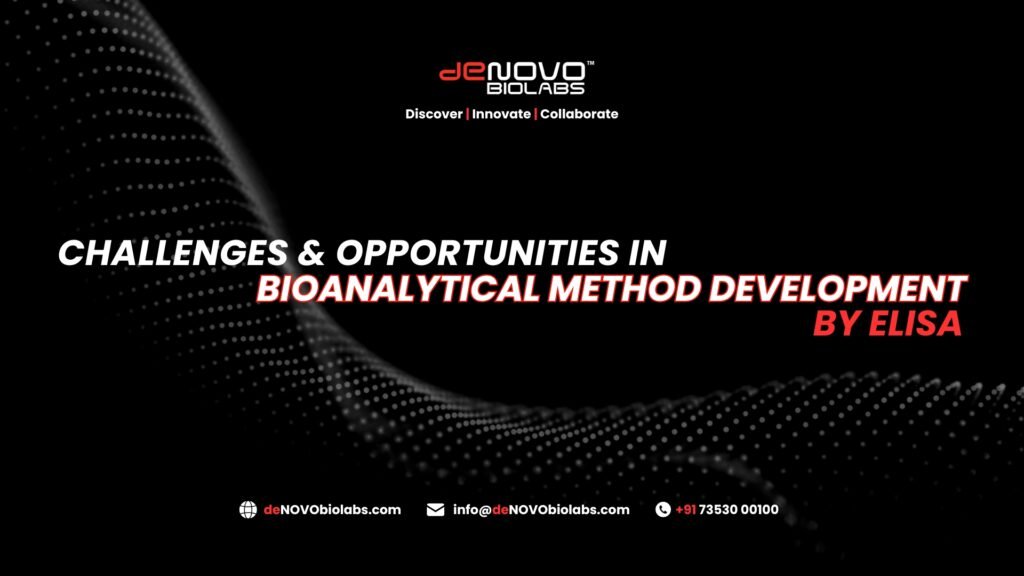
Introduction
In the complex world of biopharma, diagnostics and clinical research, one process quietly drives accuracy and trust:
bioanalytical method development.
Whether it’s quantifying therapeutic antibodies, detecting biomarkers, or validating immunoassays, the enzyme-linked immunosorbent assay (ELISA) remains the workhorse of analytical reliability.
But here’s the truth:
As therapies evolve, traditional ELISA workflows face growing pressure to deliver more — more precision, faster validation, and global reproducibility.
So how do scientists overcome these challenges without compromising data integrity?
And more importantly, where do the opportunities lie for innovation?
Let’s break it down.
Why ELISA remains the Gold Standard in Bioanalytical Testing?
Despite the rise of multiplex and LC–MS/MS technologies, ELISA remains the most widely adopted platform for quantifying proteins and antibodies in biological matrices.
✅ It’s cost-effective
✅ Highly scalable for routine testing
✅ Offers robust sensitivity for therapeutic and diagnostic applications
According to MarketsandMarkets, the global immunoassay market is projected to reach USD 39.8 billion by 2028, with ELISA being the backbone of that growth.
But while the method’s reliability is unmatched, developing and validating an ELISA-based bioanalytical method isn’t as straightforward as it seems.
Challenges
Each ELISA assay is a story and most don’t start smooth.
Here are some of the biggest hurdles labs face during method development:
1. Antigen and Antibody Selection
The success of any ELISA hinges on one thing: the quality of reagents.
If the antigen or antibody pair isn’t specific, sensitive, or stable enough, even the most sophisticated setup can fall short.
- Non-specific binding can inflate background noise
- Low-affinity reagents can lead to poor reproducibility
- Batch-to-batch variability in polyclonal antibodies can disrupt long-term consistency
This is why recombinant proteins and validated monoclonal antibody pairs are increasingly preferred — for their defined structure, purity, and lot-to-lot reproducibility.
deNOVO Biolabs, for instance, provides LFA-validated monoclonal antibody pairs and recombinant antigens tailored for IVD applications, ensuring consistent assay performance.
2. Matrix Effects and Interference
When working with biological samples such as serum or plasma, matrix effects can skew results.
Endogenous components often interfere with antigen-antibody interactions, affecting both sensitivity and accuracy.
Mitigation strategies include:
- Optimizing dilution buffers
- Using matched matrices for calibration curves
- Employing blocking agents to minimize non-specific binding
Despite these approaches, achieving linearity and recovery across biological matrices remains one of the toughest ELISA challenges.
3. Standard Curve Stability
Another major pain point?
Standard curve inconsistency — especially in long-term studies.
Environmental fluctuations, reagent degradation, or inconsistent coating procedures can all distort signal intensity.
Best practices involve:
- Using high-purity recombinant standards
- Performing real-time stability studies
- Applying robust QC controls across runs
Consistency starts with well-characterized proteins — and that’s where high-grade recombinant standards make the difference.
4. Time-Intensive Validation Cycles
Bioanalytical validation — as per FDA and EMA guidelines — requires demonstrating accuracy, precision, selectivity, recovery, and robustness.
Each parameter involves multiple iterations of testing, often extending project timelines by weeks or even months.
Automation, data integration, and standardized assay kits have emerged as the next frontier to streamline this process.
Opportunities
Challenges also open doors.
The push for accuracy, reproducibility, and global standardization has created an environment ripe for innovation in ELISA-based bioanalytics.
1. Recombinant Technology for enhanced consistency
Gone are the days of variable antibody batches.
Recombinant technology now allows scientists to engineer antibodies and antigens with precise binding characteristics, ensuring every assay run performs the same way — today, tomorrow, or a year from now.
💡 Example:
deNOVO Biolabs’ Recombinant TNF Alpha protein, developed for IVD applications, offers exceptional purity and bioactivity — making it an ideal reference standard for immune response assays.
“Recombinant reagents are not just replacements — they’re the reason modern diagnostics can scale globally without losing accuracy.”
2. Advanced detection systems
Newer detection formats — including chemiluminescent and fluorescence-based ELISAs — are improving assay sensitivity by up to 10–100x compared to traditional colorimetric methods.
These advances not only support early-stage biomarker detection, but also enable quantification in complex matrices with higher precision.
3. Data automation & Digital ELISA platforms
Digital transformation is redefining bioanalysis.
Platforms integrating AI-driven curve fitting, automated validation checks, and cloud-based LIMS systems are cutting method development time drastically.
According to McKinsey & Company, labs adopting data-driven workflows have seen up to 40% faster validation cycles and improved decision-making accuracy.
4. Collaboration across CROs & Biotech Partners
In today’s landscape, collaboration is power.
CROs, biotech startups, and diagnostics companies are increasingly partnering with specialized reagent manufacturers for custom antibody and antigen solutions — instead of developing everything in-house.
This not only saves time but ensures scientific rigor and regulatory alignment from day one.
deNOVO Biolabs –
Driving reliability in ELISA-based bioanalytics
At deNOVO Biolabs, we understand that reliability in bioanalytical testing begins with one thing — reliable reagents.
Our portfolio includes:
- Validated monoclonal antibody pairs for Dengue NS1 and HBsAg
- Recombinant TNF Alpha protein for IVD applications
- Native CRP and HBsAg Ad/Ay antigens
- LFA-tested antibody pairs ready for diagnostic manufacturers
Every product is developed with a focus on purity, performance, and reproducibility — validated through clinical-grade testing and partner feedback.
Whether you are designing an ELISA for infectious diseases, biotherapeutic monitoring, or immunoassay standardization, our reagents help you achieve data you can trust — every time.
Interested to learn more?
Register here for the upcoming webinar on October 23, 2025 at 3 pm IST
